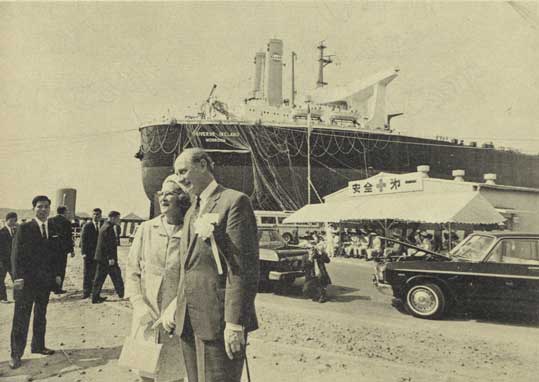Documents on Irish Foreign Policy—a user’s guide
Published in Issue 5 (September/October 2022), News, Volume 30By John Gibney
The thirteenth volume in the Royal Irish Academy’s Documents on Irish Foreign Policy (DIFP) series will be published in November 2022, on-schedule, despite the disruption caused by Covid-19.
DIFP was established in 1997 as a partnership between the Royal Irish Academy, the National Archives and the Department of Foreign Affairs, and publishes archival material relating to Irish foreign policy since 1919. Since 1998 it has done so in hard-copy volumes published every two years (after an interval these are made freely available online at www.difp.ie).

Above: Taoiseach Jack Lynch and his wife Máirín in Yokohama, 15 August 1968, during the first official visit to Japan by an Irish leader, a subject covered in DIFP Vol. XIII. The super tanker in the background, Universe Ireland, was intended to serve the oil refinery at Whiddy Island in Bantry Bay, Co. Cork. (NAI)
The series is arranged chronologically; each volume covers a discrete span of years, generally demarcated by the terms of governments. Volume XIII covers the tumultuous era from April 1965 to June 1969. The turmoil of the late 1960s in Europe, the United States and the Middle East is reflected in the documents published in the volume alongside issues closer to home like the beginning of the ‘Troubles’. But how does one go about pulling such a publication together?
Published editions of archival material have a long pedigree and are intended to make primary source material more easily and immediately accessible. DIFP is no different. The vast bulk of what is published in the series comes from the records of the Department of the Taoiseach and the Department of Foreign Affairs now held in the National Archives in Dublin (where DIFP is physically based), with material from other repositories also occasionally included. Documents in the volumes have already been released under the 30-year rule specified under the National Archives Act of 1986, though on rare occasions material has had to be declassified prior to inclusion.
DIFP operates on a two-year publication cycle, with the first year devoted to research, and the second to editing. But there are limits to what can be physically published, so what are we looking for when we start to go through what are often vast collections of material? The key word is ‘policy’. We are primarily looking for material that sheds light on how decisions were reached, and on what informed how policies were made. If we think of the information contained in the departmental files as percolating upwards to enable those decisions to be made, then we work our way back down through the chain of command.
The first items for inspection are cabinet minutes, which give an indication of what aspects of foreign policy were important enough to get the attention of the government. From there we look through the files of the Department of the Taoiseach, from where decisions usually emanated, followed by those of the secretary (now secretary-general) of the Department of External Affairs (it was only renamed Foreign Affairs in 1971). From there we work downward, weeding out repetition along the way, through the political and economic reports submitted to the secretary of the department by ambassadors, the ‘general registry’ headquarters files of the department in Dublin, and finally into the files of the individual missions and embassies, as sent back to the National Archives.
Over the course of the first year a cache of thousands of documents emerges. We photograph those that we think are candidates for publication, noting its metadata (such as sender, recipient and date sent), and rank it in terms of its likely importance. This collection is then whittled down by the project staff and the academic editors into a more manageable figure in the high hundreds. The documents now selected for likely inclusion are typed up, and we read out the document as typed against the original to check the accuracy of content. At the same time, we try to make the selection as comprehensive but tight as possible by editing it down even further: documents are cut in their entirety, and extraneous and incidental material is excised. Readers will see ‘[matter omitted]’ sprinkled throughout the volumes but this is never used to hide or excise sensitive material. The documents are in the public domain, so readers can check what we have omitted against the originals in the National Archives.
Then comes annotation. We need to explain what is referred in the documents via footnotes. This involves piecing together the world in which the documents were created. While these may be diplomatic documents, they cover a vast range of topics, and it would be fairer to describe the contents of the DIFP series as an exploration of Irish history through diplomacy rather than just diplomatic history. As a project publishing edited source material on late twentieth-century Irish history, DIFP is unique.
Finally, following the documents come the introduction, index, supporting material and preparation of selected facsimiles by the National Archives’ conservation department, after which, gentle reader, a DIFP volume makes its way into the world.
And then we start all over again. But in the meantime, Documents on Irish Foreign Policy, Vol. XIII: 1965-69 will be available from the Royal Irish Academy later this year.
John Gibney is Assistant Editor with the Documents on Irish Foreign Policy series.
















